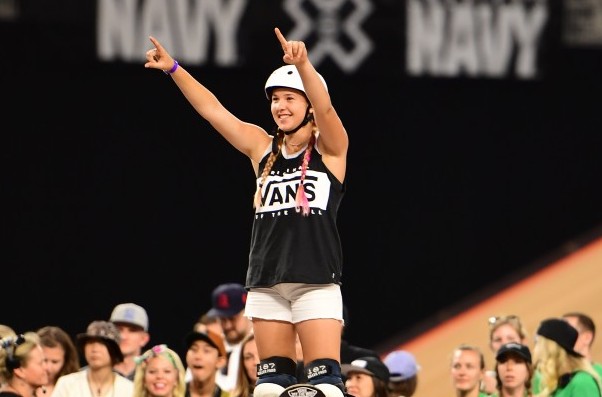
Back in February, Chloe Kim entered the 2018 Winter Olympics in Pyeongchang as “The Future of Snowboarding.” It turned out calling her the future sold her short, as Kim came out of those games with a gold medal. Fast forward to today and the Summer X Games are here, and with women’s skateboarding set to make its debut at the Summer Olympics in 2020, a few more young women hope to establish themselves as the sport’s version of Kim.
While women’s skateboarding won’t debut in the Olympics for two more years, it has a long history at the highest level of extreme sports competitions as it first appeared as an X Games event in 2002. One year later, Mimi Knoop competed in her first X Games, and after a decorated career, she is now the creative director for women’s skateboarding at the event.
“I originally was an actual competitor and was competing myself for several years,” Knoop told Uproxx Sports. “And then we ended up starting to run our own events around 2005, 2006. Since then, that’s what I’ve been doing. So I stepped out of the competition ring and then more into the behind-the-scenes work. ”
Knoop went from skating in parks to picking which parks female skaters would ride in when she formed The Alliance in 2006 with Cara-Beth Burnside and Drew Mearns. The Alliance has worked on putting together women’s skateboarding events for the X Games, as well as other skating events like the Mountain Dew Tour. Some of the core tenants of The Alliance are making sure that women get equal pay for competing while making sure that the selection of the skaters remains inclusive.
“I have an organization that puts together a couple selection committees, and those selection committees are women from all around the world that have their finger on the pulse of their local scenes,” Knoop says. “What we do is we put together the lists of the skaters that end up being invited to X Games, and then they all vote on it, and we keep it super democratic and try to make sure that the best of the best are featured.”
Among those invited to this year’s Summer X Games is Jordyn Barratt, a 19-year-old skater from Hawaii. Barratt took to skating when she was 12 despite the fact that everyone else in the town loved to surf.
“I ended up picking up a board and loving it the second I picked it up,” Barratt says. “Six months went by and I was still skating really everyday. I’d wake up at 5:30 in the morning before school begging my mom to take me to the skate park. And I would say, ‘I dreamt about a trick I want to learn. Please take me before school. I can’t wait.'”
Barratt’s passion for skating is in her genes, as her mother, Joanne, skated with her three older brothers when she was a child. Jordyn could skate whenever she wasn’t in school, but it came with a caveat: Her mother had to go with her to the parks to make sure she would be fine.
“She was like, ‘Oh, this is kind of cool, but I’m gonna stay with you at the skate park, because you’re the only girl and the only kid with a bunch of 30 year old guys,'” Barratt recalls. “She just wanted to be there, but she thought it was awesome, she loved it right away. She was super supportive and still is.”
Barratt will compete in the Park skating side of the things, which uses more bowls and ramps than rails and ledges — those are commonplace on the Street side of the competition. Park will have 12 skaters from all over the world working to put together the most technical yet visually appealing set of moves in 50 seconds (skaters call their routines “lines”). After the qualifiers are over, the field is cut in half, with the six remaining skaters battling it out for X Games gold and momentum towards the 2020 Olympics.
As Barratt — who took home bronze in the event in 2016 and silver a year later — points out, the key to Park skating is creativity.
“A big thing in park skating is putting your line together,” Barratt explains. “Every single person that’s competing can do a different line. That’s how many options there are. So my goal is just to create a really creative, fun line and to have some new tricks that I’ve been working on, as well as some old ones that I’ve been improving on, and just to put it all together and make my complete run. If I make my complete run, I know I will be stoked no matter what the outcome is.”
Barratt is just one example of how this year’s field picked by Knoop and the rest of The Alliance is loaded. It’s a sign of growth from the days when Knoop was skating, noting that the participation numbers are only rising.
“The main difference in terms of the standards and the ability level is climbing each year,” Knoop says. “The participation numbers have really gone up in the last 10 years in girls skateboarding, so there’s just so many more girls competing and skating for fun and so that kind of pushes everyone to skate even better because there’s more competition. So yeah it’s a little more wild these days.”






